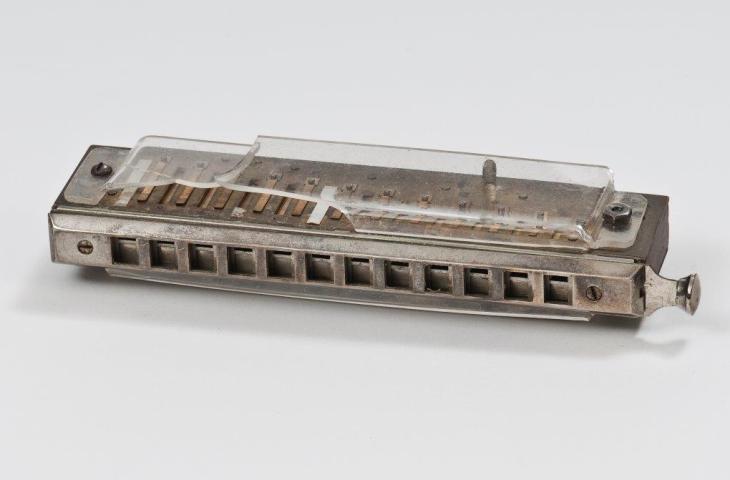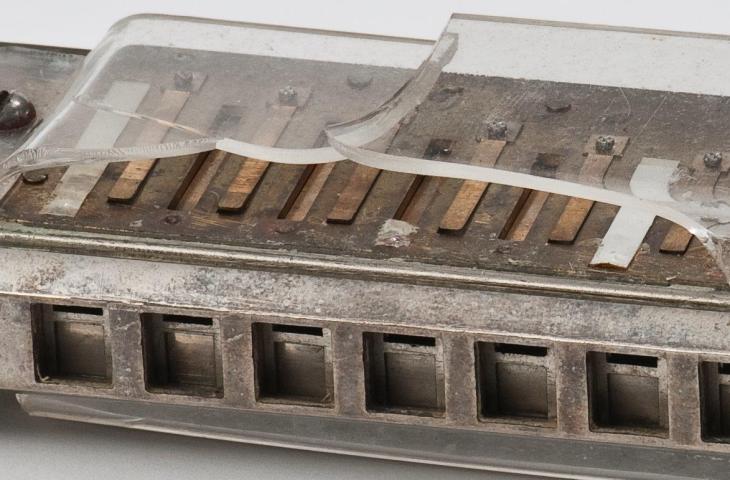April 2022
Fig.1

Harmonica, Hohner, Trossingen, before 2000, inv. 2017.0019.011
Fig.2

Harmonica, Hohner, Trossingen, before 2000, inv. 2017.0019.011
This April, the exhibition ‘Toots 100: The Sound of a Belgian Legend’ opens at the Royal Library (KBR), a few steps from the MIM. As result of a collaboration between KBR and the Royal Museums of Art and History via the MIM, this is an exhibition full of sounds and documents that traces the phenomenal career of the greatest jazz harmonica player: Toots Thielemans (1922-2016). Several instruments from MIM’s collections are of course included in the exhibition, but there are many others to be discovered in the museum, such as a rather special harmonica that belonged to Toots.
But first, a few reminders. The harmonica is a wind instrument with ‘free reeds’. Made of a thin metal plate, the reed which sets the air in vibration to form a sound, is said to be ‘free’ because it moves freely on either side of its axis, from its resting position. In the case of the harmonica, the reed is set in oscillation by the action of an air flow generated by the player’s breath.
The first harmonicas appeared in Vienna in 1825, before conquering all of Europe, then the United States and the rest of the world. Initially purely handmade, their production became industrial and reached 50 million units annually in the mid-1920s. Among the main producers of harmonicas was the German firm Hohner, founded in Trossingen in 1857, which popularised this small, inexpensive instrument that could be taken everywhere with you.
There are two main types of harmonicas: diatonic and chromatic. To use an easy comparison, the diatonic is essentially limited to the white notes of a piano keyboard, while the chromatic can play all notes, semitone by semitone. Under its protective cover plates, the chromatic harmonica contains the elements of two diatonic harmonicas, tuned a semitone apart. Thanks to a small lever on the side of the instrument, called a ‘slide’, the musician can select either of the internal harmonicas in order to access all the notes of the scale. Clever!
The standard chromatic harmonica has 12 round or square holes and a range of three octaves. Each hole has four reeds, two accessible without the use of the slide and two requiring the slide, whether the notes are blown or sucked in by the player. In total, there are 48 small vibrating reeds.
Toots Thielemans always played on chromatic harmonicas of the Hohner brand, especially the Chromonica models, the reference series of the brand. Introduced in 1925, the Chromonica is also the best-selling chromatic harmonica in the world. The specimen shown here has a wooden comb, brass reed plates and reeds, and Plexiglas cover plates that allows the reed plates and the reeds to be seen. All reeds are hand-tuned before leaving the factory, and then need to be periodically serviced and re-tuned.
Hohner also produced two chromatic ‘jazz’ harmonica models stamped by Toots, based on a Chromonica: the Toots' Hard Bopper with a powerful sound and the Toots' Mellow Tone with a warmer tone. These are to be seen in the exhibition at KBR!
Text: Géry Dumoulin